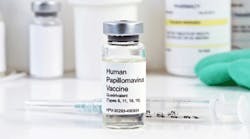The new HPV vaccine consensus statement advocates for vaccination as early as age 11.
Experts at the National Cancer Institute (NCI) and others have unified to support human papillomavirus (HPV) vaccination to prevent cancer. HPV can cause cancer of the cervix, anus, and throat. The HPV vaccine can prevent most of these cancer cases but few girls and boys in the United States get the vaccine. (1) This article will review the new statement.
The Centers for Disease Control (CDC) states that 27,000 men and women are diagnosed with an HPV-related cancer each year in the United States, equivalent to one new case of cancer every 20 minutes. (2) The HPV vaccine can prevent most of these cancers but only 40% of girls and 21% of boys received the vaccine in 2015. (3)
READ MORE | Staying ahead of the grim reaper: Oral cancer screening tools can help save lives
The CDC recommends:
- Boys and girls receive three doses of HPV vaccine at ages 11 or 12 years. The HPV vaccine series can be started in preteens as early as age 9 and should be completed before the 13th birthday. The HPV vaccine is more effective the earlier it is given; however, it is also recommended for young women until age 26 and young men until age 21.
- Parents and health-care providers protect the health of our children through a number of actions:
- We encourage all parents and guardians to have their sons and daughters complete the 3-dose HPV vaccine series before the 13th birthday, and complete the series as soon as possible in children aged 13 to 17. Parents and guardians should talk to their health care provider to learn more about HPV vaccines and their benefits.
- We encourage young men (up to age 21) and young women (up to age 26), who were not vaccinated as preteens or teens, to complete the 3-dose HPV vaccine series to protect themselves against HPV.
- We encourage all health-care providers to be advocates for cancer prevention by making strong recommendations for childhood HPV vaccination. We ask providers to join forces to educate parents/guardians and colleagues about the importance and benefits of HPV vaccination. (4)
There are several HPV vaccines approved in the United States: a bivalent vaccine (Cervarix, GSK) that prevents infection with HPV types 16 and 18; a quadrivalent vaccine (Gardasil) that prevents infection with HPV types 6, 11, 16, and 18; and a 9-valent vaccine that prevents infection with HPV types 6, 11, 16, and 18, 31, 33, 45, 52, and 58. The bivalent and quadrivalent vaccines offer protection against HPV types 16 and 18, which account for 66% of all cervical cancers, and the 9-valent vaccine protects against five additional types accounting for 15% of cervical cancers. The quadrivalent HPV vaccine also protects against types 6 and 11, which cause 90% of genital warts. (3)
READ MORE | Oral cancer screening: To charge or not to charge?
The CDC also recommends other types of preemptive measures to prevent sexually transmitted diseases (STDs). An example is The Five P’s: Partners, Practices, Prevention of Pregnancy, Protection from STDs, and Past History. (5)
Let’s do our best to help curb oropharyngeal cancer due to HPV. First educate yourself and learn the facts about the virus and how it is transmitted. See the Human Papillomavirus (HPV) and Oropharyngeal Cancer - Fact Sheetfrom the CDC. (6) Commit to the cause of raising awareness and vaccination as a part of the prevention efforts to reduce risk. Lead the conversation about how the HPV vaccination has the potential to prevent nearly 3 out of 4 cancers caused by persistent HPV infections. Then, as you are performing an oral cancer examination, explain the risk factors for developing oral and oropharyngeal cancers. Tobacco use, excessive alcohol consumption, and unsafe sex or oral sex are some of the behaviors that puts a person at risk. There are tools with questions and answers provided to help guide you through these conversations. (7)
You are the key to cancer prevention!
References
1. Newly drafted consensus statement promotes widespread use of HPV vaccines to prevent cancer. News Medical.http://www.news-medical.net/news/20160128/Newly-drafted-consensus-statement-promotes-widespread-use-of-HPV-vaccines-to-prevent-cancer.aspx. Published January 28, 2016. Accessed February 17, 2016.
2. Human Papillomavirus (HPV). CDC website. http://www.cdc.gov/hpv/index.html. Updated September 30, 2015. Accessed February 17, 2016.
3. Human Papillomavirus (HPV) Infection. http://www.cdc.gov/std/tg2015/hpv.htm. CDC website. Updated June 4, 2015. Accessed February 17, 2016.
4. NCI-designated Cancer Centers Urge HPV Vaccination for the Prevention of Cancer. Fred Hutch website. http://www.fredhutch.org/en/news/center-news/2016/01/cancer-centers-consensus-hpv-vaccine.html. Published January 26, 2016. Accessed February 17, 2016.
5. 2015 Sexually Transmitted Diseases Treatment Guidelines. CDC website. http://www.cdc.gov/std/tg2015/clinical.htm. Updated June 4, 2015. Accessed February 17, 2016.
6. Human papillomavirus (HPV) and oropharyngeal cancer – fact sheet. CDC website. http://www.cdc.gov/std/hpv/stdFact-HPVandoralcancer.htm. Updated November 22, 2013. Accessed February 17, 2016.
7. Human papillomavirus – Answering the questions patients may have. CDC website. http://www.cdc.gov/hpv/hcp/answering-questions.html. Updated February 8, 2016. Accessed February 17, 2016.







